LCS Laboratory Inc. helps homeowners identify the unique composition of the dust in their homes and address potential air quality concerns. Our analysis helps uncover sources of contamination and potential indoor air quality issues, empowering homeowners to make informed decisions about maintaining a healthy home.
What We Test For in Residential Dust
- Construction and Renovation Dust: Includes particles such as wood dust, metal shavings, rust, paint chips, paint droplets, and fibreglass, which are common after construction or remodelling projects.
- Textile Fibres: Identifies wool, cotton, synthetic fibres, and carpet dust, often found in high-traffic areas or spaces.
- Biological Particles: Detects mould spores, which may indicate humidity problems or water damage. Other particles, such as skin cells, insect parts, pollen, human and animal hair, can cause allergies and suggest the need for deeper cleaning.
- Outdoor Environmental Dust: Identifies plant tissue, pollen, and other natural outdoor particles that infiltrate indoor spaces.
We utilize Phase Contrast Microscopy, Polarized Light Microscopy, and specialised staining to examine dust samples. This comprehensive approach enables precise identification and quantification of each particle type, ensuring a detailed and accurate analysis.
How to Collect and Submit a Sample
- Dust Collection: Collect a small dust sample (at least the size of a coffee bean) from floors, furniture, or a vacuum cleaner.
- Packaging: Place the sample in a Ziploc bag and label it with the collection location (e.g., “kitchen table dust” or “office dust”).
- Complete the Request Form: Download our request form, providing your contact details, sample identification, turnaround time, and specific test requirements.
- Shipping: Send the labelled sample and completed request form to our laboratory in London, Ontario. If you are shipping from outside of Canada, please check the international shipping instructions.
For questions or assistance with the submission process, please feel free to contact us.
Convenient Online Ordering
For instant quotes and secure online ordering, visit our online store:
More details can be seen on our YouTube channel














5 Responses
Hello – My wife and I are plagued with dust entering the living area of our house via the warm air return vent grates. We would like to know what the grey colored dust is composed of. Does your firm analyze such dust?
Hello Mike. Yes we do analyse such samples using light microscopy
Can you do an analysis based upon provided photographs taken by others, with a microscope? If so, I have light, polorized and dark-field scopes. Would stains (I have several) be of value? Suggested magnification, etc. This would be for my own residence. We have far too much dust in this place and it is affecting my spouse’s health.
Hello Pat, I think we can. I sent you an email of what we need.
I cleaned out my Aunt’s apartment after she passed away, and ended up storing items for various family members. After moving a Mahogany side table, I had a burning red rash with blisters. Since then, I’ve had a problem with dust in my house that’s causing the same painful red rash and blisters all over my skin. Are you able to test for particles in the dust that may cause severe contact dermatitis? I’ve tried cleaning everything, dusting my house top to bottom with a damp cloth to better capture the dust, and I’m at my wits end. I need to find out what this is so I can completely remediate the problem.